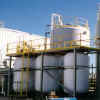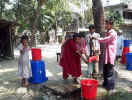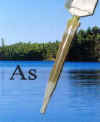TECHNOLOGIES DEVELOPED
Professor Meng and his
colleagues have developed three water treatment techniques and an arsenic
speciation method.
Direct Coprecipitation Filtration
Process

A
direct coprecipitation filtration (DCF) process has been developed for removal
of arsenic, selenium, chromium, lead, and cadmium from water. The
operating procedures and costs of the process are similar to those of
conventional sand filtration processes. The process has been successfully
implemented for the removal of arsenic from groundwater. The saturated
filters are regenerated by backwash with water. Moreover, conventional
sand filters and activated alumina filters can be upgraded to the DCF systems.
Household Filtration Unit

A
household filtration process has been developed for removing arsenic from well
water in Bangladesh. The process includes co-precipitation of arsenic by
adding a packet (approximately 2 g) of coagulants to 20 liters of well water and
subsequent filtration of the water through a bucket sand filter.
Experimental results obtained from the participating families in Bangladesh have
demonstrated that the process could remove arsenic from approximately 300 to
less than 50 mg/L. The participating families have been using this simple
and affordable process to prepare clean water for drinking and cooking since
March 2000. A larger scale field test is currently underway.
Activating Iron Filtration Unit
An
iron filtration process has been developed for the removal of chromium, arsenic,
mercury, lead, cadmium, phosphate, and chlorinate organic compounds from water.
The filtration system consists of a Fe column and a sand filter in series.
The unique design of the Fe filter (patent pending) prevents the fusion of the
iron filings and keeps the iron active. Heavy metals are removed by the Fe
filings through electrochemical reduction and co-precipitation. The sand
filter removes the suspended solids and the residual metals passing through the
Fe column. The organic compounds are dechlorinated by the iron filings.
Field pilot scale tests will be conducted for the treatment of arsenic and
chromate.
Arsenic Speciation
Cartridges
The disposable cartridges offer a simple and inexpensive way for separation of
arsenate and arsenite in water samples. Each cartridge is packed with 2.5
g of highly selective adsorbent. For sample preparation, simply attach a
cartridge to a syringe and filter 50 mL of sample in less than a min. Arsenate
in the sample is completely removed by the cartridge while arsenite species
remain in filtered water. The arsenic species can be separated at a pH
range 4 to 9.
The cartridges have been
used by environmental laboratories and research groups in the U.S., Canada, and
Sweden.
|